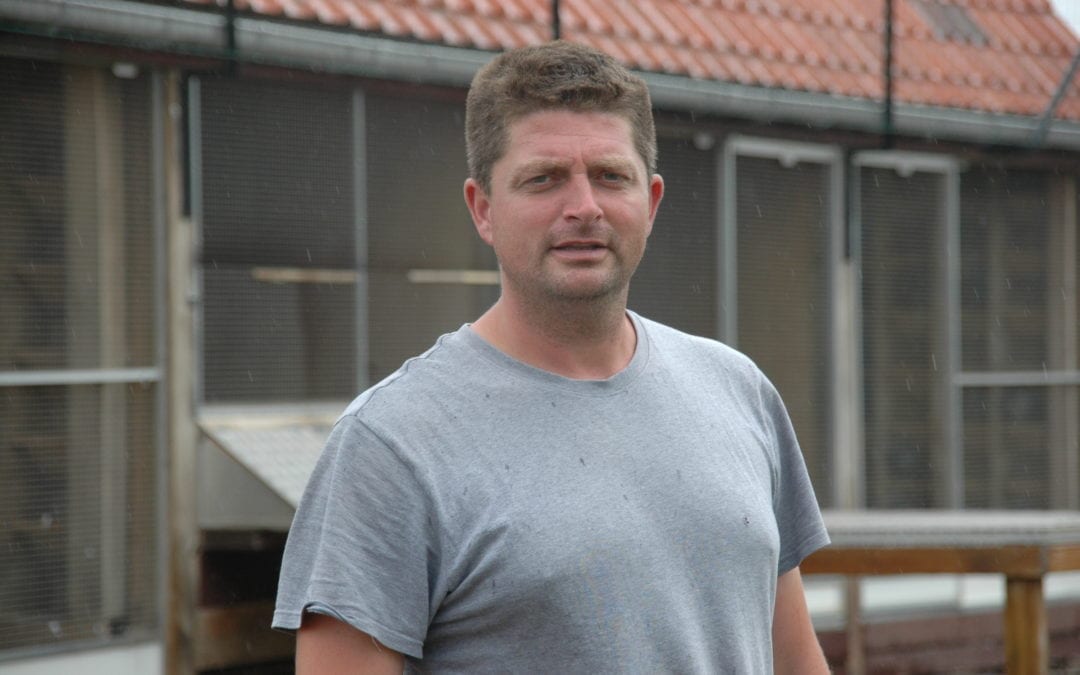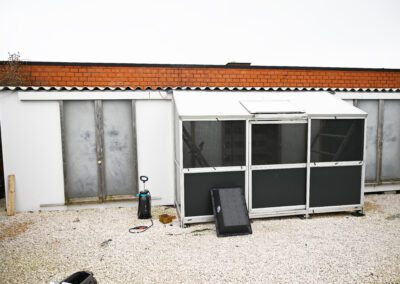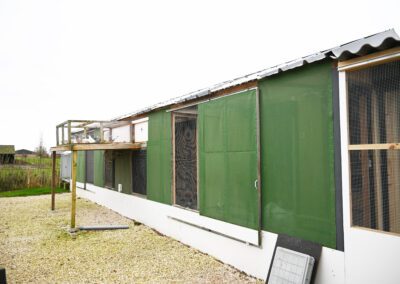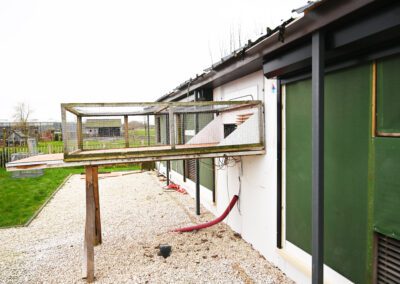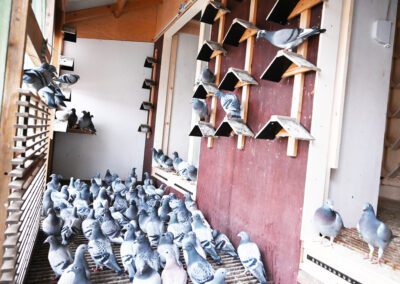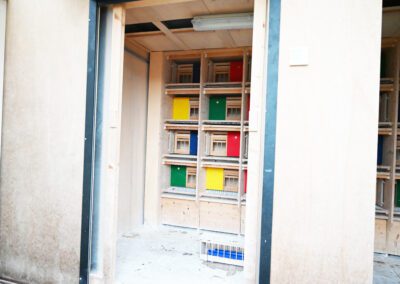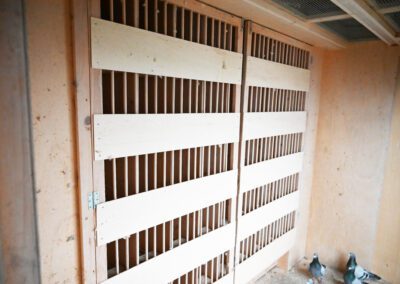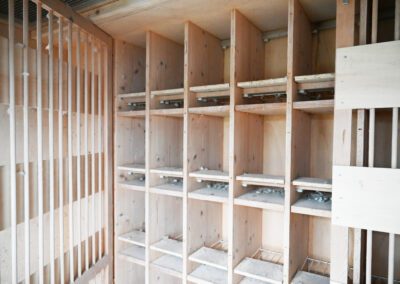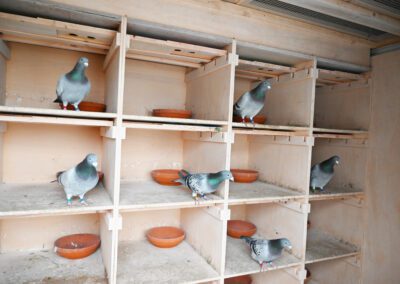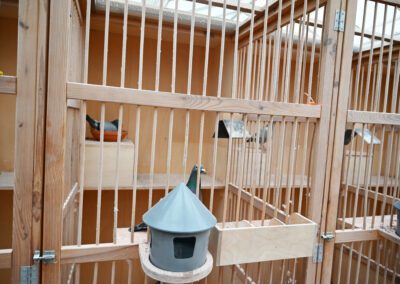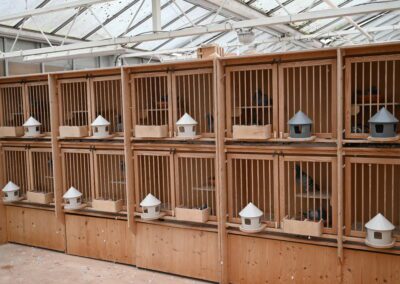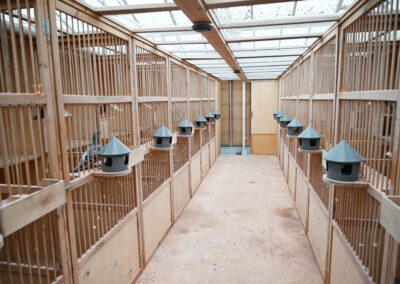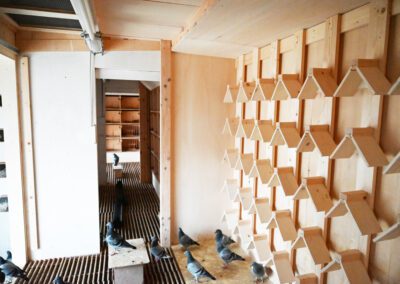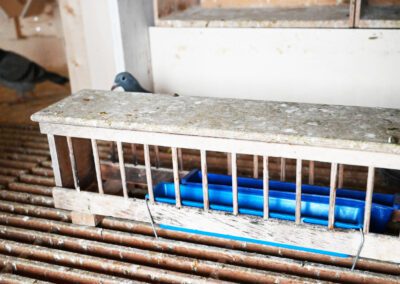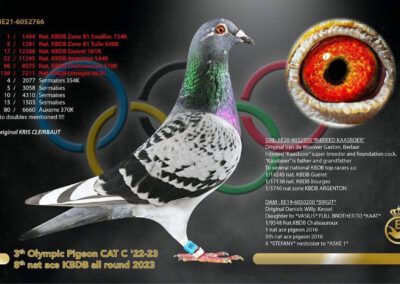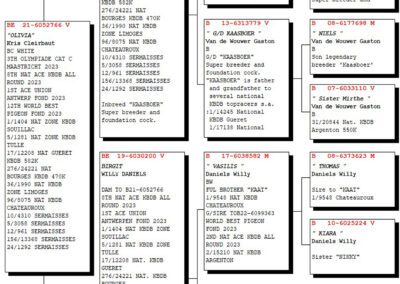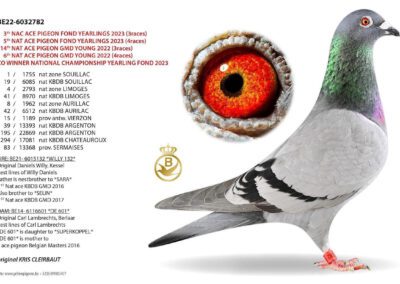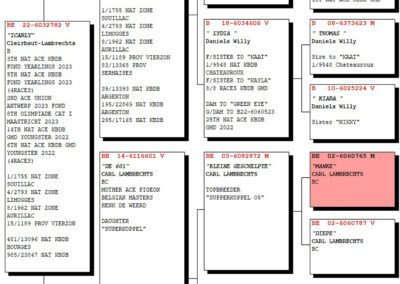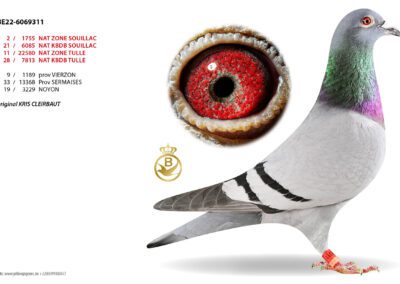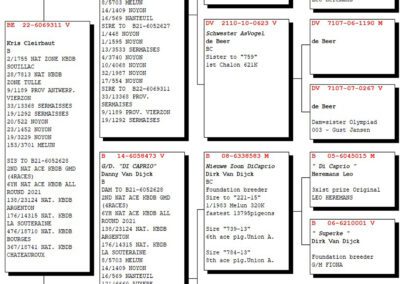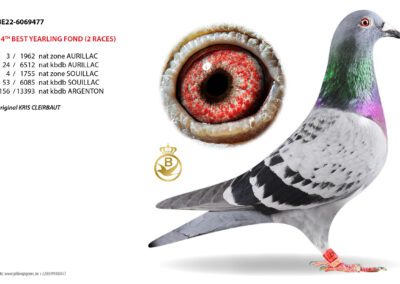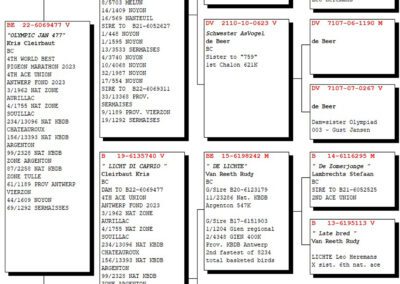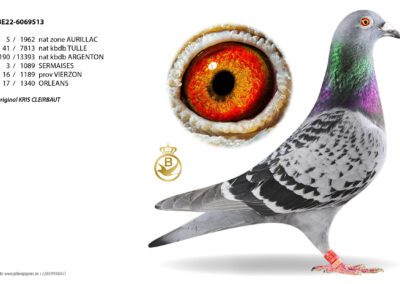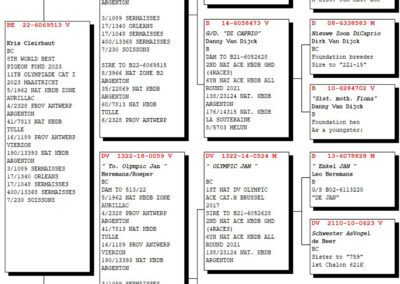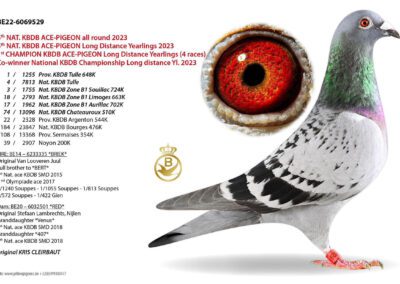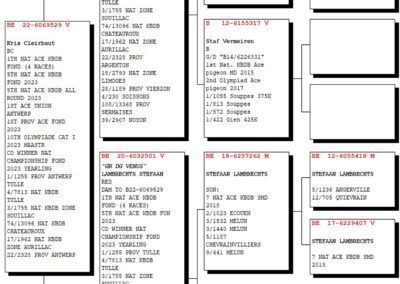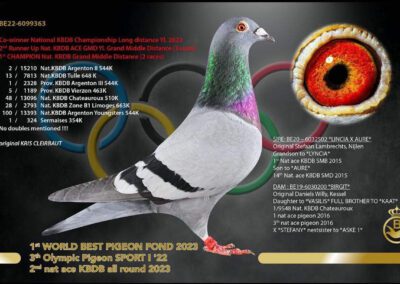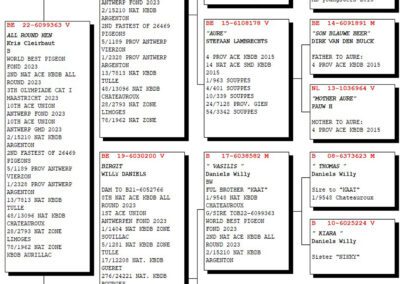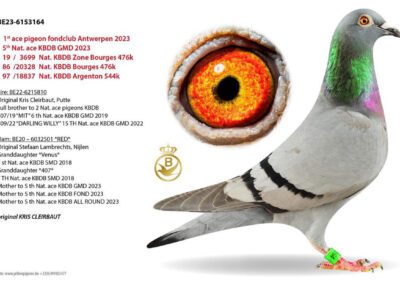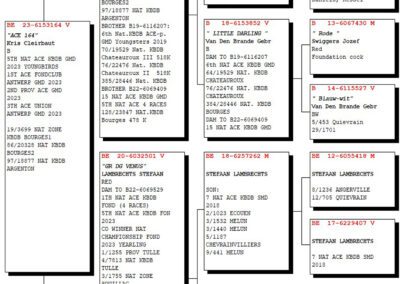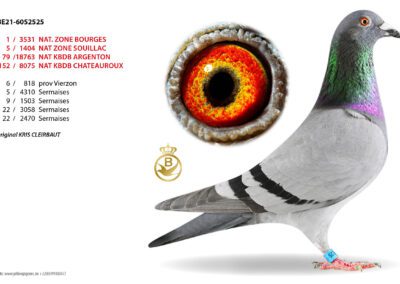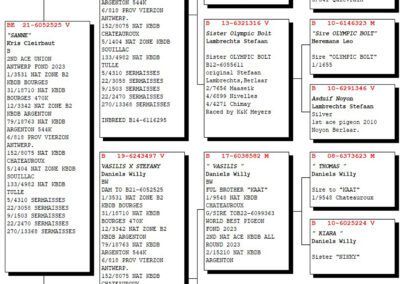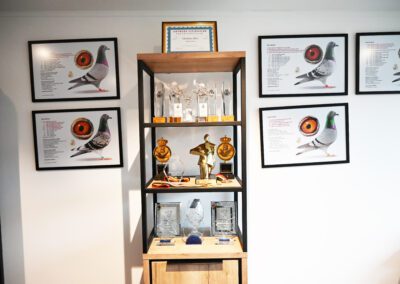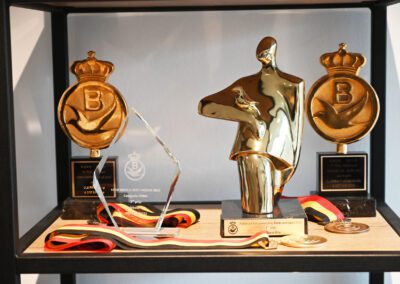20 QUESTIONS TO THE NATIONAL ACE BIRD WINNER GREAT MIDDLE DISTANCE KBDB YOUNG BIRDS: ROZIERS-XIANG
Itegem: Roziers-Xiang…or the combination Jelle Roziers (35 y) and Green Xiang (China) … make since 2015 a successful combination. Jelle Roziers has been known for years now for his ‘stunt results’ and that hasn’t changed the past few years. This is how this tandem won last year, when they raced from the lofts in Bevel, 2nd National Bourges against 27,980 young birds (lost with 13 seconds) and won the 2nd and 7th National Ace bird GMD KBDB! In the meantime they moved to Itegem…and the loft moved along and look…at the end of the season of 2017 Jelle and Green can show off with their 1st National Bourges against 38,445 young birds (also the fastest of 59,243 Bourges racers) and 1st, 10th, 11th, 17th, 19th, 37th, and 43rd National ace bird GMD young birds KBDB !
A BIT OF HISTORY
In 2004 Jelle Roziers started of his pigeon fancier’s career as loft manager at Hubert Schroyens, brother in law from Jef Houben. Two years later Jelle started a combination with Kris Cleirbaut but one season later (2007) he raced again out of his own garden together with his father Paul and took on a new start. The successes came quickly as that same season they won 2nd National Bourges (grandchild ‘Queen L’), 25th National Argenton, 6th National La Souterraine (grandchild ‘Queen L’) 9th National Gueret (grandchild ‘Queen L’). That year they raced 40 young birds on the national races and managed to qualify 19 times within the Top-100 National!
In 2008, 2009, 2010 and 2011 the successes continued and they started to race the year birds as well.
As from 2012 until 2016 they raced only young birds in Bevel and now from 2017 on the new address in Itegem.
QUESTION TIME
- “Jelle… let’s start off with your breeding loft. How many breeding couples do you keep and do you yearly invest in new talent?”
I’ve got 40 breeding couples which all reside in breeding boxes. As you all know, I’ve build my entire strain around hen ‘Queen L’ (B04-6277729). “Queen L” won in 2004 1st National La Souterraine and was never sold despite all the offers made. She was coupled against top birds from the Houben family like f.e. “Pinoccio”, “Reno”, “Rivaldo” and until the day of today this breeding line still forms the bases of all my top pigeons. We also co-bred successful with Jos&Jules Engels (“Vader Argenton” x “Queen L”).
I can state that in all my breeding couples one of the two partners has ‘Queen L’ marked in the pedigree.
Whether I get new ones yearly? Yes…also I am looking constantly for reinforcement. Most of all I like to buy the champion itself but honesty makes me say that this isn’t always possible financially. A tip for many is to get eggs out of the best racing pigeons from a strong racing fancier. You have to have some patience as a fancier and the eggs of racers in April or autumn are payable. This way I also invested successfully in eggs from Fe. Vercammen and Casaert I was also successful with pigeons from Geerinckx, Eddy Noël and Gert Heylen. In 2017 we also raced young birds from Bros. Hansen (Denemark), Henrik Meldgaard (Denemark), Peeters-Van Crombruggen (Nijlen), and Bros. Bogemans (Lier) and from my uncle Walter Roziers (Berlaar).
- “While coupling the breeders, are you watching specific characteristics? Do you re-couple the breeders a lot?”
Coupling pigeons…believe it or not, but I don’t know much about it either…I’ve got my own theories where I hold on to and these are:
1. I like to see a pigeon with a strong pigmented eye. The eyes can be covered with ‘clouds’…you know what I mean.
2. I always have the best results when coupling a ‘raced pigeon’ against a ‘non-raced pigeon’. I can’t prove anything scientific, but experience confirmed me this already very often.
3. When you have a proven base pigeon, let this one come in as much as possible. Many champions aren’t champions anymore after a couple of years as they don’t hold on to the ‘genes of the winner’. Breeders who have already given youngsters with results are couples that I won’t split up easily, unless you don’t want to breed champions off course.
3.”Do you make use of A.I. or do you replace the eggs in order to breed more young birds out of a certain couple?”
No…please let nature take its course. I would say don’t force them to much. Where are all the guys with their ‘A.I.-pigeons’…I don’t think they are our strongest competitors are they…
- “How many young birds do you breed for yourself to race with?”
From the 1st round 90 and from the 2nd round 95. - “Once weened…how does the care looks like?”
From the moment on the youngsters are weened they get a ‘courageous’ mixture. They still have to grow out and can use all available nutrition. I use mixtures which have been put together by Eddy Noël.
Once all the young birds eat and drink very well I start of like this: I mix something in the drinking water and/or over the food every day. I’m an advocate of pre-probiotics (these are all from different companies) and during the weekend I add sours in the drinking water.
More than once a week I mix Omega Oil from Backx over the food. I only mix the oil, so I don’t dry it out with brewers’ yeast or minerals. I hold on to this system until they start of to fly well. - “Jelle…what do you do in a medical way…you also do have a youngster that gets sick once in a while?”
Off course…you don’t have to think that everything runs without a problem over here. Once the youngsters are 6 weeks old I will add every three weeks the known yellow drops over the food. I mix one soupspoon yellow drops with 1kg food. And then I state the next thing and it might be possible that not many readers will believe it, but all who gets sick and isn’t recovered after 6 days is taken out without compassion. Also when they suffer from adeno I refuse to give them antibiotics. I have no mercy for all those who don’t recover fast. This Spring I already took out at least 10 young birds from the loft. In a matter of speaking they can’t have 5 feathers lying in the wrong direction or they are out. I know this is a very hard method, but you can’t be strict enough as a fancier. I also used to have all different kind of antibiotics ready to interfere directly but I really wonder whether this is all so much better…sometimes I get the feeling that they recover equally fast when you don’t give anything. The only thing that I do provide is Tollyamin Forte (Schroeder).
7.”I assume that you darken and enlighten them afterwards?”
Exactly…at 17h30 the curtains are closed to open them again at 7h30. This as from weening until half of July.
Enlighten happens from Bourges II from 6h in the morning until 22h in the evening. During the day the lights are being turned off.
8.”As from which period on do your young birds have to train well or can they build up slowly? “
Look…on the 26th of February the first round of young birds where weened and if they train half May well, I’m a happy fancier. So once half of May has passed I will do anything within my power to get them in the air. It will start with a change in the menu. The ‘courageous’ mixture will be changed into a more light mixture namely ‘Racing Mix I’ (composed by Eddy Noël). I feed this until there’s only a bit of barley left and then the food is being taken away. When they young birds are sitting outside I also scare them up once in a while. Please note …I will only do this maximum once a day so they don’t get scared.
Now we are the beginning of June…the youngsters will be released once a day in the morning…and now I give for the first time a cure of 7 days against trichomoniases. This with tricho powder from the vet where we add for every 10 liters of water use 3 soupspoons of grenadine. After this cure they normally start to take off and then the feeding is being changed again and will get ‘50% Racing Mix 2’ and ‘50% Racing mix 3’.
- “Many fanciers complain of the many losses amongst the young birds…how this is in your case? “
Well…I also do suffer losses, but this gets less and less every year. Probably due to my hard selection that I apply since a few years. I always say…whether you suffer many or few losses…in the end it is all about the top pigeons that remain. - “When do the first training races start off?”
Once I stimulate the youngsters in flying everything takes a leap. Believe it or not but around the 10th of July I start off with the first training flights. As my young birds didn’t see more then Itegem by then I toss them from a very short distance. I sometimes toss them twice a day. Everything depends off course on the weather conditions, but when these are fine…let’s rock and roll. - “How far do you drive?”
There is a difference between pigeons that haven’t been on a race with the club and those who already did. As long as they didn’t have a Quièvrain with the club, I drive them not further then 30km. Once they have a Quièvrain race in their wings I drive them to Ittre (60km). - “Do you teach the young birds to drink in the baskets?”
Drinking in a basket is something they know from the first day that they are weened…I don’t have any drinking pots on my lofts but they drink out of the known ‘blue drinking bowls’ that are also attached to the baskets in the trucks. - “Do you race your young birds on sliding doors or pure widowhood?”
I race my young birds on the sliding door system. Half of June they are being separated and then both the cocks and hens fly out twice a day. Once the national races come up they train again only once a day. During the week they don’t have to train for hours what I’m concerned. The less they train the better…when they take off for a minute and then get back full speed, that’s enough for me. As they have to race every weekend they can spare their energy during the week a bit.
What the sliding door system is concerned…at the day of basketing the sexes don’t come together and after a race they are being separated again already from the moment the prizes are over. So no ‘after party’ on these lofts. - “Within a few weeks the first national race for young birds is on the program namely Bourges…how do you prepare for that?”
The period from June on until Bourges is a very important period. Nothing can go wrong then and we have to light a very fat candle in order for the ‘shape-fairy’ to find her way onto the loft. Once they had their first race out of Quièvrain and this until Bourges National I keep the rhythm up by letting them race another Quièvrain in the middle of the week (with the club) or to drive them myself to Ittre (60km). In a matter of care I keep onto my former mentioned schedule with sours and pre-probiotics. Now they also get the yellow drops weekly over the food.
About three weeks before Bourges the young birds have to race Gien Provincial (400km). After this race I give them a cure with Soludox and that’s it. Even when the youngsters suffer from one-eye-cold I won’t do anything special. I used to drop them 3x a day, but I even don’t have any eye drops left in my cupboard. One-eye-cold is a virus and you can’t give anything against a virus. In August I did use twice ‘Dry disinfector’.
- Which race do your young birds have to race in between 2 national races or do you keep them at home?
That’s simple…the most far distance that we can send them to. Is it a 400km race, well they will have to go on that 400km race. At that moment I don’t push the brakes any more, and then it is full speed ahead. - How do you determine which young bird will be your 1st given?
I just don’t…I don’t look at that at all…I just take them of the loft and put them in the basket. It’s possible that my best pigeon is my last given. - Can you give us a bit more details about your loft?
My loft is made out of wood and is East/South-East directed. The front exists out of aviaries where my pigeons can go into freely. Only when they are being darkened the young birds are on the loft. In the loft itself there is along the entire roof side (both front as back) a wooden plate. Only in the ridge there is an opening where the air can escape. On the picture you will also see that the dust that comes from under the boxes is being caught so it can’t get onto the loft again.
On the bottom we have corn cobs. In the aviaries the bottom exists out of rosters which are being taken away once a week to be cleaned.
Once a year the inside of the loft is being cleaned, this with water with a huge twinge of bleach added. We don’t clean with a high pressure cleaner (as it will give too much water onto the loft) but we clean everything with a sponge. - Can you give a bit more information about your first national ace birds?
Let’s start off with the 1st National Ace bird young birds KBDB “New Queen L”. “New Queen L” (B17-6037517) was paired up with me during the season. Despite the fact that she got a lot of attention from the other hens who wanted to pair up with her, she choose me as her partner. Unique to experience this.
“New Queen L” shined with the following results for the national ace bird championship:
1 Nat (z) Chateauroux 4,949b.
12 National Chateauroux 18,499b.
103 Nat (z) Bourges 12,400b.
199 National Bourges 38,456b.
38 Prov. Argenton 3,669b.
166 National Argenton 21,915b.
A 2nd top pigeon was “Berre”; he became the 10th National ace bird KBDB Long Distance in 2017. “Berre” (B17-6230797) was bred by Paul Peeters (Peeters-Van Crombrugge). I ordered 6 young birds at Paul out of his 3 best breeding couples and I went to get them end of March. When I went to get them I got from Paul two extra ones for free. And one of them became the 10th National Ace bird KBDB with underneath results:
2 Nat (z) Chateauroux 4,949b.
13 National Chateauroux 18,499b.
35 Nat (z) Bourges 12,400b.
71 National Bourges 38,456b.
184 Nat (z) Argenton 6,069b.
455 National Argenton 21,915b.
As 3rd I would like to mention “Helen”. “Helen” (B17-6037521) scored underneath top results for the national ace bird championship:
13 Nat (z) Chateauroux 4,949b.
106 National Chateauroux 18,499b.
160 Nat (z) Bourges 12,400b.
296 National Bourges 38,456b.
46 Nat (z) Chateauroux 3,570b.
163 National Chateauroux 12,150b.
- What is the biggest mistake that you every made?
Good question…when do you make a mistake? I wouldn’t be able to answer that right away as I already made so many mistakes. Important is to learn out of your mistakes and to make sure that you won’t make the same mistake twice again. When you do that you in fact didn’t make a mistake, but you learned something and that again is a positive thing, no? - An end conclusion?
Ow man…that’s a though one…’it still can be done in an easy way within pigeon sport – keep it simple and don’t try to find too many excuses when it doesn’t work out as you want it to’ !
Jelle, thank you for this talk and we are already looking forward for you top results with the youngsters in 2018!
Stefan Mertens
